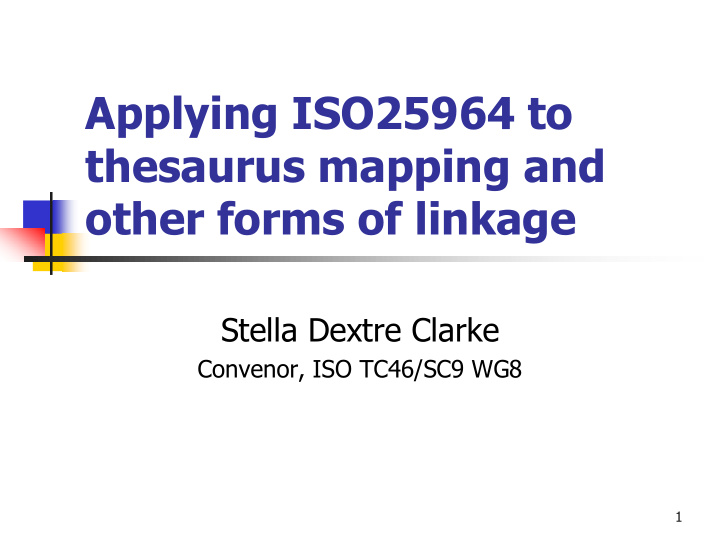



Applying ISO25964 to thesaurus mapping and other forms of linkage Stella Dextre Clarke Convenor, ISO TC46/SC9 WG8 1
In a networked world, standards underpin everything ISO2709 Z39.50 MARC 21 SPARQL Z39.19 OWL SKOS ZThes JSON REST ISO25964 RDF BS 8723 HTTP SRU XML
Introducing ISO 25964 ISO 25964: Thesauri and interoperability with other vocabularies Part 1: Thesauri for information retrieval Part 2: Interoperability with other vocabularies It updates ISO 2788 and ISO 5964 Shares common ground with ANSI/NISO Z39.19 Part 1, published in 2011 , covers monolingual and multilingual thesauri Part 2, published in 2013 , covers mapping between thesauri and other types of vocabulary information retrieval seen as main application; mapping applies to index terms or to search terms See more at <http://www.niso.org/schemas/iso25964/> 3
How to enable/encourage vocabulary linkage Present data in a standard way to enable import and use 1. in other systems (ISO 25964 Part 1) Work multilingually (ISO 25964 Part 1) 2. Conform to a standard data model (ISO 25964 Part 1) 3. Strike the right balance between tailoring to your own 4. market and embracing the outside world For Web publishing, export in SKOS format 5. To enable linked data, give each concept a URI 6. Construct mappings between the terms/concepts of one 7. KOS and those of another (ISO 25964 Part 2) 4
5
How to map (content of Part 2) Models for mapping Guidelines for mapping Recommendations on mapping types How to handle pre-coordination Mapping (linking) to/from various vocabulary types: other thesauri classification schemes file plans (Classification schemes used for records management) taxonomies subject heading schemes ontologies terminologies name authority lists synonym rings Brief guidance on handling mappings data 6
Recommended “Models for mapping” A B F C D H G E P Q R S
Full range of ISO 25964-2 mapping types Basic mapping types: Equivalence Simple Compound Intersecting compound equivalence Cumulative compound equivalence Hierarchical Broader Narrower Associative Simple equivalence can be marked as “Exact” or “Inexact”
Full range of ISO 25964-2 mapping types with examples Basic mapping types: Equivalence Simple: Laptop computers EQ Notebook computers Compound Intersecting compound equivalence: Women executives EQ Women + Executives Cumulative compound equivalence: Inland waterways EQ Rivers | Canals Hierarchical Broader: Streets BM Roads Narrower: Roads NM Streets Associative: e-Learning RM Distance education Exact equivalence: Aubergines =EQ Egg-plants Inexact equivalence: Horticulture ~EQ Gardening
Intersecting versus cumulative equivalence
SKOS mapping types similar but not identical Basic mapping “properties” (skos:mappingRelation): skos:closeMatch (symmetric) skos:exactMatch (symmetric, transitive) skos:relatedMatch (symmetric) skos:broadMatch (inverse of narrowmatch) skos:narrowMatch (inverse of broadmatch) No provision for compound mappings
Linking ISO 25964 data model with SKOS The ISO 25964 data model is broadly compatible with SKOS, especially when the SKOS-XL extension is used. See correspondence table at http://www.niso.org/apps/group_public/download.php/12351/Correspondence%20ISO25964-SKOSXL-MADS-2013-12-11.pdf An RDF schema encapsulating the mappings between models is at http://purl.org/iso25964/skos-thes 12
Want a copy of ISO 25964 ? Download it from ISO at http://www.iso.org/iso/home/store/catalogue_detail.htm?csnumber=53657 http://www.iso.org/iso/home/store/catalogue_detail.htm?csnumber=53658 Order it from your national standards body (e.g. BSI, DIN, ANSI, AFNOR) Some public/academic reference libraries may stock it It is not cheap to purchase However, the XML schema for exchange of thesaurus data is in an Annex which is available online without charge or password control. Go to http://www.niso.org/schemas/iso25964/ 13
Recommend
More recommend